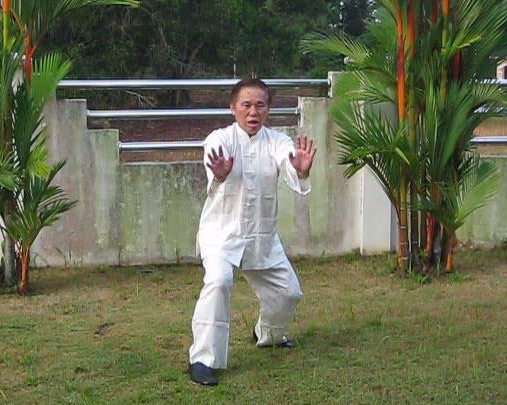HISTORY AND PHILOSOPHY OF
SAN ZHAN OR THREE BATTLES OF WUZUQUAN

San Zhan of Wuzuquan
By the time of the Yuan Dynasty (13th to 14th century) Shaolin Kungfu had developed so extensively that a kungfu genuius, Bai Yu Feng, who later became a Shaolin monk known as the Venerable Qiu Yue, was concerned that it might lose its characteristics. With the help of the abbot, he gathered the best known Shaolin masters of the time at the Shaolin Monastery at Henan to demonstrate their arts.
Five styles were outstanding. They were White Crane Kungfu, known for its presence of mind; Tai Zu Kungfu or First Emperor Kungfu, known for picture-perfect form; Lohan Kungfu, known for body position; Bodhidharma Style, known for energy cultivation; and Monkey Style, known for agility. Bai Yu Feng integrated these five styles into a new style, known as Wuquzuan or Five-Ancestor Kungfu.
My Wuzuquan teacher was prestigious. He was Sifu Chee Kim Thong, regarded as a living treasure of the Peoples' Republic of China. He did not teach me personally. The teaching was done by his eldest son, Sifu Chee Boon Leong, in their family house in Dungun, Malaysia about 1968 and 1969.
Wuzuquan, especially Sifu Chee Kim Thong's lineage, was (and still is) famous for internal force. But what I remember most vividly was my siheng, Sifu Chee Boon Leong, telling me, "mg meng yong lak", which is the Hokkian (or Fujian in Mandarin pronounciation) dialect meaning "Do not use strength". I clearly remember how could a person fight, or even have any force, if he did not use strength!
But there was no doubt at all that my classmates were very powerful. I was literally nowhere when knocking arms with them. It should be mentioned that my arms were actually also powerful, when compared to other people, because earlier I had spent many years hitting a wooden man every night when I trained Southern Shaolin Kungfu in Uncle Righteousness' school.
The main method to train internal force was San Zhan, the fundamental set in Wuzuquan. Senior disciples trained Abdominal Breathing, which was practiced behind close doors. Top disciples practiced Cotton Palm, which was of course practiced very secretly.
However, I could not develop any internal force, despite practicing San Zhan for two years. The fault was mine, not my teacher's or my classmates'. It was mind-blowing that later when I conducted a Special Wuzuquan Course in Penang in 2012, my students could develop tremendous internal force using San Zhan in just a few days! My students had prior kungfu experience before attending the course. But I also had 17 years of kungfu experience before I learned San Zhan.
At first I thought that San Zhan was meant to develop internal force. Practitioners had to learn other Wuzuquan sets for combat. But I made an amazing discovery when I was preparing to teach the Special Wuzuquan Course in 2012. I discovered that, like the Five-Elemental Fist in Xingyiquan, a master could apply any pattern in San Zhan of Wuzuquan to counter any attack!
This fact was put into good practical use a few months earlier in a Special Shaolin-Taijiquan Course in Sabah in 2011. Dr Damian used simple patterns from San Zhan to counter all forms of striking, kicking, felling and chin-na attacks.
It is not for no good reasons that San Zhan is a treasure in Wuzuquan. It is also a kungfu set that has not changed across time and space. Irrespective of whether practitioners are in Asia, America or any place in the world, practicing now, a century ago or at any time, they perform exactly the same patterns of San Zhan.
Wong Kiew Kit
21st December 2015
LINKS
San Zhan in Pictures
